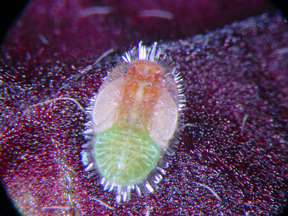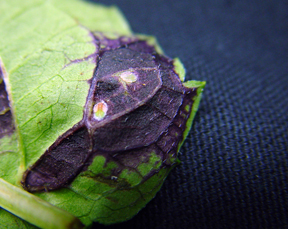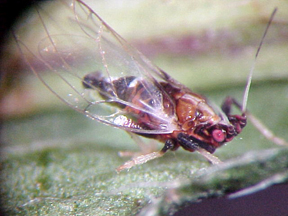Rudbeckia triozid found on perennial hibiscus
Editor’s note: This article is from the archives of the MSU Crop Advisory Team Alerts. Check the label of any pesticide referenced to ensure your use is included.
This past week Linda Whitlock, MSU Extension Kalamazoo County, inquired about a puzzling insect one of her staff found on her hibiscus leaves. Her description of the insect and damage matched that of an insect we had seen several years ago on Rudbeckia or Blackeyed Susan. This strange little bug does not have a common name; it is known scientifically as Bactericera antennata (Hemiptera: Triozidae (Psyllidae in part)). I call it the Rudbeckia triozid. Linda’s find expands the known host range of this insect.
In 2002, I sent specimens of these insects to the USDA Systematic Entomology Lab in Beltsville, Maryland where it was identified by Dr. Doug Miller. Dr. Miller said that this insect occurs well into Central America and little is known about its biology.
The Rudbeckia triozid is reported to have considerable morphological and color variation. The mature nymphs I have observed are about one-eighth inch long, flattened and very colorful with a light green abdomen, red-orange head and thorax, and white wing pads. The eyes are large and the nymph is completely fringed in white hairs. The adult is very small and has two pairs of transparent wings and red eyes. The body is mostly black with brown highlights on the dorsal aspect of the thorax. The legs are two-toned with the bases black and ends tan.
The nymphs feed by inserting their needle-like mouthparts into lower surfaces of the leaf and sucking plant fluids. The nymph’s saliva appears to have systematic effect throughout the leaf. First, a shallow but distinct depression develops at the feeding site on the lower leaf surface. The tissue surrounding the feeding site turns deep purple on both leaf surfaces. However, the top surface of the feeding site remains green in most cases. The veins may turn purple over much of the lower leaf surface.
The nymphs are heavily parasitized (over 90 percent) by a small black and red wasp. There appears to be one generation per year in Michigan. Their overwintering habits remain a mystery.



 Print
Print Email
Email






